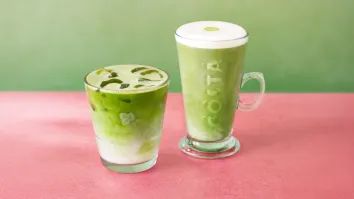Milking it: Plant-based milks enter the mainstream
Lincoln and York marketing manager Chris Tough discusses why plant-based milks are no longer just an option for retailers.
In the coffee industry, we’re used to change. From black filter coffee to fresh coffee in a bag, there are few similarities to how coffee is served today compared to ten or even five years ago.
2020 will be no different as plant-based milks enter the mainstream. The challenge for anyone serving coffee, is to understand how best to work with and serve these milks.
Just under a quarter of people drink non-dairy milks, including 33% of 16 to 24 year olds. For these consumers, health was the leading factor (37%), followed by concerns for the impact of dairy farming on the environment (36%).
There are many health benefits to choosing a non-dairy milk, as well as environmental. Dairy farming output, per 200ml, contributes roughly the same volumes of emissions (kg), land (sq. m) and water use (L) as Rice, Soy, Almond and Oat milk farming combined. And, as we know, for the 16 to 24 year olds who drink their coffee with a plant-based milk, this matters.
But what does this mean for the businesses serving fresh coffee?
However, much like how the origin of your coffee bean can determine the roasting, brewing and flavour of your coffee, the same can be said for milk.
Milk impacts upon many aspects of a coffee’s final foam and flavour. Traditionally, coffees used steamed milk, producing a foam by ‘stretching’ the milk. Each element of the milk contributes to its ability to froth, foam and add flavour. For this reason, it is whole milk that has dominated demand traditionally as its greater proportion of proteins and fats enable it to perform ‘better’, because of the caseins and serum.
Which milk is worth the money?
Soy Milk
Soy milk already boasts a rich history and is one of the go-to dairy-free milk options, with almost 1 in 10 consumers choosing to have Soy milk in their coffee. Its key selling points include its accessibility, affordability and the high protein content which makes it easy to replicate the smooth foamy textures of a dairy milk.
Soy is one of the most sustainable options for milk production. With the lowest water use requirement of any of the alternatives, and middle of the pack for emissions and land requirements, it’s a truly viable option to reduce the environmental impact of coffee consumption.
Almond Milk
A nut milk that comes in both sweetened and unsweetened varieties, almond milk’s popularity has steadily been on the rise in recent years, with 6.7% of Britons now requesting it in their coffee. As consumers become increasingly health and environmentally conscious, we expect almond milk will continue its current trajectory given its flavour, but importantly for consumers, per-glass (200ml), almond farming produces the least emissions of its alternatives and requires the second-least land for farming.
However, not everyone has gone ‘nuts’ for almond milk. Whilst its required water usage per 200ml is somewhat lower than dairy, it is noticeably more than other non-dairy alternatives. It also lacks the same levels of protein as dairy milk and could leave your coffee with a layer of wateriness beneath the foam generated.
Coconut Milk
Coconut milk is rising to prominence with 6.6% of coffee drinkers now requesting it. From 2018 to 2019, sales of coconut milk rose by 16% in contrast to the year before, heavily influenced by British consumer’s switch to veganism.
Coconut milk is creamy, naturally dense and packed with healthy fats, making it a firm favourite as its foam is also more bubbly than dairy milk, giving it a livelier appeal but a quicker disintegration rate. The natural sweetness of a coconut’s flavour is prominent. Some may argue that it distracts from the flavours of the coffee but that would depend on the coffee, of course.
Oat Milk
Oat milk carries that wheat-like flavour with it. Its malty notes are favoured by many coffee drinkers already and is probably cow’s milks biggest rival. Oat milk’s naturally thick, buttery, creamy texture pedestals it alongside dairy milk for texture and flavour.
It also boasts many beneficial components, as it’s void of saturated fat but loaded with protein, fibre and natural sweetness. Oats also contain beta-glucans which help with aiding heart health and lowering cholesterol.
When considering the future sustainability of Oat farming, it is another highly promising sign and one that will have considerable influence over the growth in popularity of this product.
No other country in the world has had higher search interest in oat milk than the UK in the past 12 months. Given its recent market entry, the consumption of oat milk is currently lagging behind soy and almond with a ‘request’ rate of 4.4%, for now, at least.
Cashew Milk
Cashew nuts can be expensive and come at a price. Whilst this may not be an issue for some, the likelihood of cashew milk being adopted on a national scale by high street coffee shops is unlikely, as we expect consumers are unlikely to want to pay more, and businesses will be reluctant to absolve the costs themselves.
Cashew milk carries less of the nuttiness but does give you a sample of its natural sweet flavour along the way, as well as that creaminess we love! However, despite its characteristics, Cashew milk is requested just 0.1% more than rice milk, which as noted above, is really up against it when fighting for market share.
Cashew milk does give a decent ‘stretch’ in contrast to other non-dairy alternatives but, in doing so, it produces larger bubbles, making the foam less dense and producing a more bubble bath-like texture.
Rice Milk
A dairy-free milk that is absent of both nut and soy, makes rice milk a particularly popular option for coffee drinkers with nut allergies and those who are lactose intolerant.
In comparison to other plant-based milks, it is light, refreshing, and holds a subtle flavour bringing a neutral taste, allowing the flavour of the coffee to triumph. However, it is watery and lacking in protein meaning it does not generate the foam-like texture some consumers are looking for.
As it stands, rice milk has a rather meagre ‘request’ rate at just 0.6%. Given its perhaps less well-suited flavour to be paired with coffee and its environmental failings in contrast with Almond, Soy and Oat milk.
But why does it even matter?
Scientifically, I think we can agree that the milk does matter. Understanding the properties of milk will definitely help improve its performance in a coffee.
Beyond the science, the rise of plant-based alternatives will present new challenges for food service businesses. Firstly, the cost of buying non-dairy milks is more expensive and the time taken to make a coffee may increase. Furthermore, given the varied characteristics of these milks, educating baristas on how to make the perfect cup will take some time. However, it isn’t just a case of additional cost and effort.


























